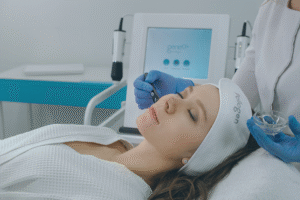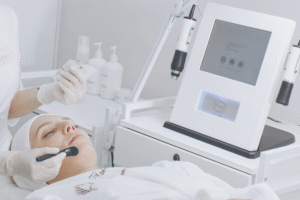
OxyGeneo Treatment Information: What Aestheticians Should Tell Their Patients Before the Session?
Many skincare enthusiasts walk into their first OxyGeneo session expecting instant transformation, a glowing, lifted face in just one go.
More Posts

Many skincare enthusiasts walk into their first OxyGeneo session expecting instant transformation, a glowing, lifted face in just one go.

Mastering the OxyGeneo machine can seem overwhelming for clinics new to the technology, especially when ensuring consistent, safe, and effective
Send Us A Message
In Dubai’s highly regulated medical and aesthetic landscape, beauty and dermatology clinics must balance compliance with patient safety when integrating advanced technologies like the Oxygeneo machine. Imagine offering clients visibly rejuvenated skin while maintaining full adherence to health authority standards, both achievable with the right protocols. Backed by proven clinical studies and trusted by dermatologists worldwide, Oxygeneo delivers safe, results-driven treatments when used correctly. This guide on Oxygeneo safety instructions and contraindications helps professionals uphold patient trust, meet compliance requirements, and ensure every session aligns with the highest medical and ethical standards.

Ensure your clinic meets the highest safety standards with the OxyGeneo Facial Machine from Skyline Medical – the trusted solution for exfoliation, oxygenation, and nourishment.
Safe operation of the OxyGeneo machine begins with following the manufacturer’s essential safety protocols designed to protect both practitioners and clients. The Oxygeneo machine safety manual clearly emphasizes that only trained, certified professionals should operate the system, ensuring proper use and minimizing risks during every OxyGeneo facial. Adhering to these guidelines is essential to preventing equipment damage and ensuring full compliance with medical safety standards in regulated environments, like aesthetic clinics in Dubai.
To maintain these safety standards and deliver consistently safe treatments, practitioners should understand the reasoning behind each rule in the manual. Below are the most critical OxyGeneo safety instructions for safe, compliant device operation:
The OxyGeneo system must only be used by trained and certified professionals. This ensures operators understand the machine’s electrical and technical components, minimizing misuse and preventing client injury. Unqualified handling, in contrast, may lead to incorrect settings, overheating, or treatment inconsistencies.
Because the OxyGeneo device is an electrical unit, it must never be operated, placed, or stored near sinks or humid environments. Water exposure increases the risk of electric shock and internal damage, jeopardizing both patient and practitioner safety.
One of the key strengths of the GeneO+ machine is its versatility in addressing a wide range of skin concerns. From pigmentation and acne to signs of aging and dull, tired skin, Oxygen therapy treatment offers tailored solutions that meet individual client needs, thanks to its multiple treatment modes, including:
The Oxygeneo system should be connected only to the original applicators, power cords, and adapters supplied by the manufacturer. Using unapproved accessories can cause malfunctions, inconsistent energy delivery, or even permanent damage to the device.
Only certified technicians or authorized service centers are allowed to service or repair the OxyGeneo machine. Unauthorized alterations may void the warranty, interfere with safety systems, or create hidden hazards that compromise oxygeneo treatment safety.
Practitioners must visually inspect the OxyGeneo cables, plugs, and applicators before every session. Damaged cords or components may lead to electrical failure, shocks, or sudden power interruptions during an OxyGeneo facial, putting clients at risk.
The Oxygeneo device should not be used on areas such as the eyes, breasts, groin, or armpits. These regions contain sensitive tissue that can react adversely to the machine’s radiofrequency or exfoliation functions, resulting in discomfort or localized injury.
Oxygeneo must be kept away from flammable materials like alcohol, acetone, or disinfectants. Even small sparks from static electricity can ignite fumes, creating fire hazards during treatment preparation.
Ensuring the safe and proper use of the OxyGeneo machine necessitates understanding its contraindications, as outlined in the OxyGeneo machine safety manual and other clinical resources. The most common oxygeneo contraindications include pregnancy, active skin infections, recent invasive treatments, and certain chronic or vascular conditions that may heighten risks during an OxyGeneo facial. Recognizing and evaluating these conditions before each session is essential to maintaining both treatment efficacy and patient safety.
Below, we explore the primary oxygeneo facial contraindications in detail to help practitioners make informed and compliant treatment decisions:
➕ Read more about: What is an Oxygeneo Machine?
Most OxyGeneo facial products are considered exceptionally safe, with side effects that are typically mild and temporary. When following the Oxygeneo safety instructions, clients will see minor side effects limited to short-term reactions that usually resolve within 24 hours and require minimal aftercare. To help clinics prepare and respond effectively, below are the most common Oxygeneo facial side effects and their expected outcomes:
Bruising or Pigmentation Changes: If the device is misused or applied to contraindicated skin, localized bruising or temporary pigmentation shifts may appear. While such cases are rarely to happen, they underline the importance of following Oxygeneo safety instructions and proper technician training.
The key to ensuring both client safety and the longevity of the device after each session is to follow a structured Oxygeneo facial protocol that combines proper machine care with clear post-treatment guidance. By adhering to the Oxygeneo safety instructions, clinics can guarantee that every treatment remains effective, hygienic, and risk-free. To achieve this, it is important to focus on two areas: first, maintaining the Oxygeneo machine in optimal condition after each session, and second, providing clients with clear guidance on how to care for their skin following treatment.
After each session, clinics should follow these steps to maintain the Oxygeneo machine in optimal condition:
Power Down Safely: Switch off the device and unplug it from the power source before cleaning or storage. This step protects staff from electrical hazards and prolongs the machine’s lifespan.
Client guidance after an Oxygeneo session is equally important to maximize the benefits of the Oxygeneo facial and minimize temporary reactions:
➕ Read more about: OxyGeneo Treatment Information: What Aestheticians Should Tell Their Patients Before the Session?
Dubai skin clinics can integrate the Oxygeneo machine safely by following a structured approach that combines professional training, rigorous maintenance, and thorough documentation. Staff must be trained according to the Oxygeneo machine safety manual and adhere strictly to all Oxygeneo safety instructions to minimize risks and deliver consistent results. Clinics should also establish a regular maintenance schedule, including cleaning, servicing, and inspection of the device and its applicators. Equally important is maintaining detailed records of client treatments, noting any Oxygeneo contraindications or adverse reactions, as this helps ensure personalized care, compliance with safety protocols, and optimal long-term outcomes.
➕ Explore the Best Oxygeneo Machine in the UAE and learn more about what sets this innovative Geneo+ apart from other options in the market.
Achieving safety and effectiveness with the Oxygeneo machine depends on strict adherence to the Oxygeneo safety instructions and contraindications. Therefore, clinics should ensure staff are properly trained, the device is regularly maintained, and clients are carefully screened to minimize risks. By combining professional handling with clear client guidance, clinics can consistently deliver optimal results. Take action today and review the Oxygeneo safety instructions and contraindications to protect clients and provide safe, reliable treatments.
Yes, the OxyGeneo facial is safe when performed by trained professionals following the manufacturer’s guidelines. Clinical studies and the OxyGeneo safety instructions confirm that the treatment is non-invasive and suitable for most skin types. Temporary side effects, such as mild redness or slight swelling, are rare and usually resolve within 24 hours. By adhering to proper protocols, screening for Oxygeneo contraindications, and providing post-treatment care, clinics can ensure that every OxyGeneo facial is both effective and safe for clients.
After an OxyGeneo facial, it is important to follow proper post-treatment care to ensure optimal results and avoid irritation. Clients must avoid using harsh exfoliating products, retinoids, or chemical peels for at least 48–72 hours. Other recommendations include avoiding skin exposure to excessive sun, tanning beds, or high heat, and refraining from heavy sweating or intense workouts immediately after treatment. Following the recommended OxyGeneo facial protocol helps protect the skin and reduce the risk of temporary redness or sensitivity, resulting in a longer-lasting rejuvenation.
No, an OxyGeneo facial is generally not recommended during pregnancy. According to the OxyGeneo safety instructions and contraindications, pregnant or nursing clients are considered a contraindicated group due to potential risks. So, it is essential for expectant clients to consult their healthcare provider before scheduling any treatment